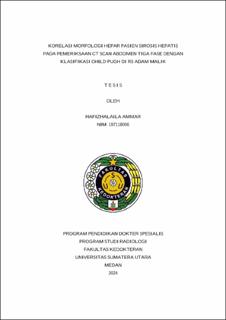| dc.description.abstract | Introduction: Cirrhosis contribute significantly to global mortality, morbidity, and economic strain, which accounting for around one million deaths annually. Liver morphology is essential for assessing the severity of cirrhosis, based on radiology examination, and clinical assessment that associated with the Child-Pugh (CP) classification.
Research: This observational analytic with cross-sectional study, using medical records of 35 cirrhosis patients aged ≥ 19 years, that underwent a three-phase abdominal CT scan between January 2022 and August 2024. The study aimed to evaluate liver morphology, including liver contour, liver volume, and LD/CRL-r ratio. Patient demographic such as age, gender, etiology, and Child-Pugh classification were also documented.
Results: Subjects was predominantly male (80%), with the most common age groups being 50-59 years and ≥ 60 years (33.3%). The primary etiology was viral (71.4%), specifically hepatitis B. A strong and significant correlation was found between the Child-Pugh classification and liver morphology, including liver contour (r = 0.706; r = 0.692; p < 0.01), liver volume (r = -0.532; r = -0.672; r = 0.532; r = 0.656; p < 0.01), and LD/CRL-r ratio (r = -0.720; r = -0.798; r = 0.524; r = 0.636; p < 0.01). The most significant parameters in each Child-Pugh classification were liver contour in class A, LD/CRL-r ratio in class B, and both liver contour and liver volume in class C.
Conclusion: There is a strong and significant correlation between the liver morphology of cirrhosis patients on three-phase abdominal CT scan and the Child-Pugh classification. | en_US |


